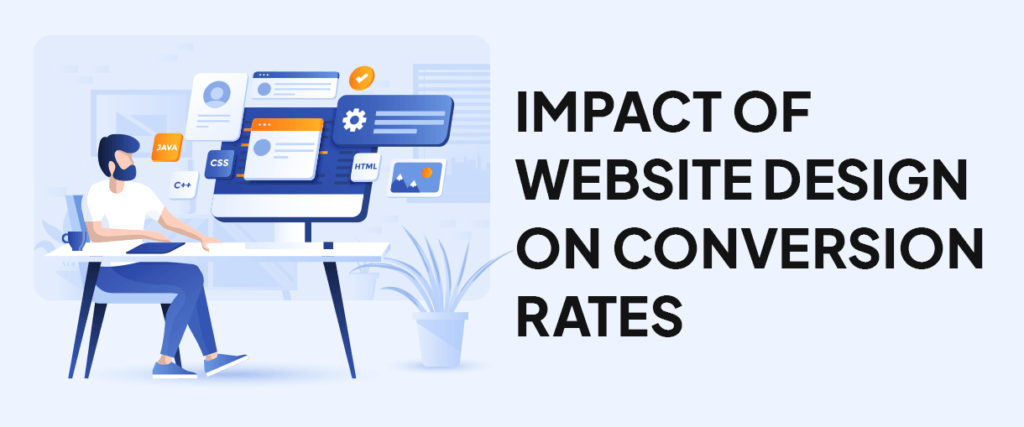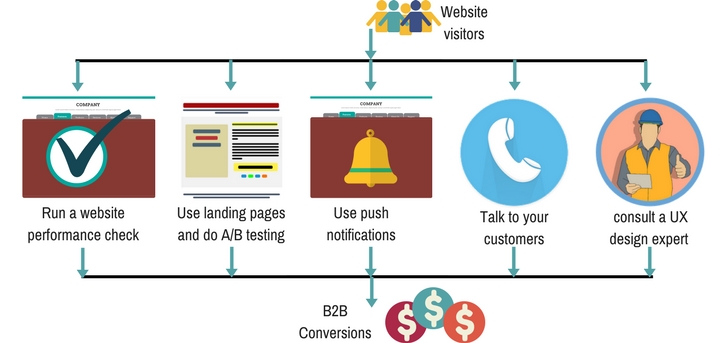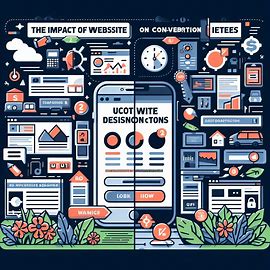The impact of website design on conversion rates is undeniable in today’s digital landscape. As businesses increasingly rely on their online presence to drive sales and engage customers, the role of design in shaping user behavior and influencing conversion outcomes has become paramount.
From the moment a visitor lands on a website, the design elements they encounter—from layout and navigation to color schemes and call-to-action buttons—can immensely impact their likelihood of converting into customers or leads.
Understanding how website design influences conversion rates is essential for businesses seeking to optimize their online performance and achieve their growth objectives.
Whether you’re a seasoned marketer looking to fine-tune your website’s performance or a business owner aiming to boost sales and engagement, the insights shared here will provide actionable guidance to help you maximize the impact of your website design on conversion rates.
Join us as we uncover the secrets to creating compelling user experiences that turn visitors into loyal customers. Let’s delve into this intricate relationship to unravel its significance and implications.

Explanation of conversion rates and why they matter:
Conversion rates refer to the percentage of website visitors who take a desired action, such as purchasing, signing up for a newsletter, filling out a contact form, or any other goal that aligns with the website owner’s objectives.
It measures how effectively a website turns visitors into customers or leads. Conversion rates are crucial for several reasons:
- Effectiveness Measurement: Conversion rates provide a clear metric for evaluating the effectiveness of a website or specific web pages in achieving their objectives. They offer insights into how well the website performs in terms of engaging and persuading visitors to take the desired action.
- Return on Investment (ROI): Higher conversion rates typically translate to better business ROI. By increasing the percentage of visitors who convert into customers or leads, businesses can generate more revenue or achieve other goals, such as growing their email list or increasing brand awareness, without necessarily increasing their marketing spend.
- Competitive Advantage: Websites with high conversion rates have a competitive advantage over those with lower conversion rates. They can better capitalize on their traffic and outperform competitors by converting more visitors into customers or leads.
- Customer Insights: Analyzing conversion rates can provide valuable insights into customer behavior, preferences, and pain points. Businesses can make informed decisions to optimize their website, marketing strategies, and overall customer experience by understanding what motivates visitors to take action or what barriers prevent them from converting.
- Continuous Improvement: Monitoring and analyzing conversion rates allows businesses to identify areas for improvement and implement optimization strategies. By testing different website elements, such as design, messaging, and calls to action, businesses can iteratively improve their conversion rates over time, leading to long-term growth and success.
Ultimately, conversion rates matter because they directly impact businesses’ bottom lines and indicate the effectiveness of their online presence in achieving their goals. By improving conversion rates, companies can maximize the value they derive from their website and digital marketing efforts.
Overview of the role of web design in enhancing conversions:
Web design is critical in strengthening conversions by shaping the overall user experience and influencing visitor behavior. Here’s an overview of how web design contributes to improving conversion rates:
- First Impressions: A well-designed website creates a positive first impression, capturing visitors’ attention and encouraging them to explore further. Elements such as layout, color scheme, typography, and imagery contribute to the site’s overall visual appeal and professionalism.
- User-Friendly Navigation: Intuitive navigation is essential for guiding visitors through the website and helping them find the information or products they’re looking for efficiently. Transparent menus, logical site structure, and prominent search functionality enhance usability and reduce friction in the browsing process.
- Responsive Design: With the increasing prevalence of mobile devices, responsive design ensures that websites adapt seamlessly to different screen sizes and devices. A mobile-friendly website provides a consistent and optimized experience across all platforms, catering to the preferences of mobile users and reducing bounce rates.
- Clear Call-to-Actions (CTAs): Strategic placement of CTAs encourages visitors to take specific actions, such as making a purchase, signing up for a newsletter, or contacting the business. Design elements such as button size, color contrast, and wording can significantly impact the visibility and effectiveness of CTAs in driving conversions.
- Visual Hierarchy: Designing with a clear visual hierarchy directs visitors’ attention to the most critical elements on the page, such as product features, benefits, or pricing information. By prioritizing key content and organizing it in a visually appealing manner, web designers can influence user engagement and decision-making processes.
- Trust and Credibility: Trust is a critical factor in online conversions. Elements such as professional branding, high-quality imagery, customer testimonials, and security badges contribute to building trust and credibility with visitors. A trustworthy website fosters confidence in the brand and increases the likelihood of conversions.
- Loading Speed: Slow-loading websites can deter visitors and lead to higher bounce rates, negatively impacting conversions. Optimizing design elements, minimizing HTTP requests, and leveraging caching techniques help improve loading speed and provide a smoother user experience, ultimately driving higher conversion rates.
- A/B Testing and Optimization: Web design is an iterative process that involves continuous testing and optimization to maximize conversions. A/B testing allows designers to experiment with different design variations and measure their impact on conversion rates. By analyzing data and insights, designers can refine their approach and implement changes that drive better results.

Web design plays a multifaceted role in enhancing conversions by creating engaging, user-friendly, and trustworthy experiences that motivate visitors to take action.
By focusing on fundamental design principles and optimization strategies, businesses can maximize the effectiveness of their website in achieving their conversion goals.
Establishing the connection between user experience and conversion success:
The connection between user experience (UX) and conversion success is profound and multifaceted. Here’s how user experience influences conversion rates:
- Ease of Use: An intuitive and easy-to-navigate website or application enhances the user experience, reducing friction and making it more straightforward for visitors to find what they want. Users are more likely to convert When they can quickly locate the products, information, or services they need.
- Mobile Optimization: With the increasing use of mobile devices, optimizing the user experience for mobile users is crucial. A responsive design that provides a seamless experience across devices improves accessibility and ensures that users can interact comfortably with the website or app, regardless of their device.
- Page Load Speed: Fast-loading pages contribute to a positive user experience by reducing wait times and providing immediate access to content. Research shows that users are likelier to abandon slow-loading websites, leading to higher bounce and lower conversion rates. Optimizing page load speed improves user satisfaction and increases the likelihood of conversions.
- Clear Call-to-Actions (CTAs): Effective CTAs guide users toward desired actions, such as purchasing, signing up for a service, or downloading a resource. Clear and prominent CTAs strategically placed within the user journey prompt users to take action, leading to higher conversion rates.
- Visual Appeal: Visually appealing design elements, such as high-quality images, well-designed layouts, and engaging multimedia content, enhance the user experience and capture users’ attention. A visually attractive website or app creates a positive impression and encourages users to explore further, increasing the likelihood of conversions.
- Trust and Credibility: User experience directly impacts users’ perceptions of a brand’s trustworthiness and credibility. Elements such as professional design, clear communication, secure transactions, and customer reviews contribute to building trust with users. When users trust a brand or website, they are more likely to engage with it and convert.
- Personalization: Tailoring the user experience to individual preferences and behaviors improves relevance and engagement, leading to higher conversion rates. Personalization techniques, such as personalized product recommendations, targeted content, and customized messaging, create a more personalized and engaging user experience, driving conversions.
- Feedback and Iteration: Continuously gathering user feedback and iterating based on user behavior and preferences is essential for improving the user experience and optimizing conversion rates over time. By analyzing user data, identifying pain points, and addressing usability issues, businesses can enhance the user experience and drive better conversion results.
User experience is crucial in driving conversion success. Businesses can maximize their conversion rates and achieve their goals by creating a seamless, engaging, and trustworthy experience that motivates users to take action. Companies can achieve their goals by prioritizing user-centric design principles and continuously optimizing the user experience.
Navigational Elegance: Ease of Use and Conversion
A website’s navigational structure can significantly impact user engagement and conversion rates. Let’s explore the importance of intuitive navigation and how it contributes to conversion success.
- Importance of intuitive navigation for retaining visitors: Users expect websites to be easy to navigate, with clear menus, logical page hierarchy, and intuitive navigation elements. A cluttered or confusing navigation system can frustrate visitors and lead to high bounce rates.
- Elements of web design that contribute to smooth user navigation: Streamlined navigation menus, clickable buttons, breadcrumb trails, and search functionality are key design elements that enhance user navigation and facilitate website exploration.
- Case studies demonstrating improved conversion rates through navigational improvements: Real-life examples showcase how optimizing navigation architecture and simplifying user pathways can significantly increase conversion rates, highlighting the tangible impact of strategic web design decisions.

The Aesthetics of Engagement: Visual Design and Its Impact
Visual design is pivotal in capturing users’ attention and fostering engagement. Let’s explore how aesthetic considerations influence user experience and ultimately impact conversion rates.
- How visual appeal can make or break a user’s site experience: Humans are visual creatures and first impressions matter. A visually appealing website design can evoke positive emotions, build trust, and encourage users to explore further, whereas a poor design can deter visitors and undermine credibility.
- A balance between aesthetics and functionality in web design: While aesthetics are important, they should not come at the expense of functionality and usability. Effective web design strikes a delicate balance between visual appeal and practicality, ensuring that design choices align with the website’s objectives.
- Examples of aesthetic changes leading to conversion lift: Case studies and examples illustrate how strategic changes in visual design, such as refreshing color schemes, optimizing typography, and enhancing imagery, can result in measurable improvements in conversion rates and user engagement.
The Two Sides of Website Design: Pros and Cons
While a well-designed website can yield numerous benefits for conversion rates, there are also potential challenges. Let’s examine the pros and cons of website design optimization in the context of conversion rate optimization (CRO).
Pros:
- Enhanced User Experience: A well-designed website can improve the overall user experience, making it easier for visitors to navigate and find what they’re looking for, thus increasing the likelihood of conversion.
- Increased Trust and Credibility: Professional and visually appealing website designs instill trust and credibility in visitors, leading to higher conversion rates. Users are more likely to engage with a trustworthy site.
- Clear Call-to-Actions (CTAs): Effective website design often includes clear and strategically placed CTAs, guiding visitors towards desired actions such as purchasing or signing up for a service, thus boosting conversion rates.
- Optimized for Mobile: With the increasing use of mobile devices, having a responsive website design ensures a seamless experience across different screen sizes, which can lead to higher conversion rates from mobile users.
- Improved Loading Speed: Fast-loading websites provide a better user experience and have higher conversion rates as users are less likely to abandon slow-loading pages.
Cons:
- Subjectivity in Design Preferences: Design preferences can vary significantly among users, and what one person finds appealing, another may not. Thus, a design choice that may increase conversion rates for some users could potentially decrease them for others.
- Overemphasis on Aesthetics: Focusing too much on aesthetics without considering usability and functionality can lead to a visually pleasing but ineffective website design that fails to convert visitors into customers.
- Complexity Leading to Confusion: In some cases, overly complex or cluttered designs can confuse visitors and make it difficult for them to find the information they need or take the desired action, thereby reducing conversion rates.
- Lack of Adaptability: Website designs that are not adaptable to changes in user behavior or technological advancements may become outdated quickly, resulting in lower conversion rates over time.
- Impact of External Factors: While website design certainly plays a significant role, conversion rates can also be influenced by external factors such as product quality, pricing, competition, and marketing strategies, making it challenging to isolate the impact of design alone.
Understanding these pros and cons can help businesses make informed decisions regarding optimizing their website design for better conversion rates.
A Personal Tale of Transformation: How Revamped Design Revolutionized My Site
To provide a real-world perspective on the impact of website design on conversion rates, let me share my experience of undergoing a website redesign and its profound effects on my business.
Embarking on a website redesign journey was pivotal for my business and profoundly impacted my conversion rates.
As a small online retailer specializing in handmade crafts, I understood the importance of creating a visually appealing and user-friendly website to attract and retain customers.
However, it wasn’t until I decided to overhaul my website’s design that I grasped its potential to drive conversions.
While functional, the previous iteration of my website lacked the polish and professionalism to instill trust and confidence in visitors. Pages were cluttered, navigation was cumbersome, and call-to-action buttons were easily overlooked.
As a result, despite decent traffic numbers, my conversion rates remained disappointingly low.
Determined to turn things around, I invested time and resources into a comprehensive website redesign project. Collaborating with a talented team of designers and developers, we created a visually stunning and user-centric website that captivates visitors and compels them to take action.
The results were nothing short of transformative. With a sleek and modern design, intuitive navigation, and strategically placed CTAs, the new website immediately resonated with visitors.
Bounce rates plummeted, session durations increased, and, most importantly, conversion rates soared.
Customers applauded the improved user experience, citing the ease of finding products, the clarity of product descriptions, and the streamlined checkout process.
With each passing month, I watched in awe as my sales figures climbed to new heights, fueled by the enhanced effectiveness of my website in converting visitors into customers.
Reflecting on this experience, I am reminded of website design’s profound impact on conversion rates.
By prioritizing user experience and investing in it, I revitalized my online presence and unlocked new opportunities for growth and success.
Wealthy Affiliates offers a comprehensive platform equipped with tools, training, and resources that can significantly aid in optimizing website design for improved conversion rates.
Through their extensive training modules, members gain insights into the principles of effective website design, learning how to create visually appealing layouts, streamline navigation, and strategically place call-to-action elements.
Moreover, the platform provides access to website-building tools and templates designed to simplify the design process, enabling users to create professional-looking websites easily.
Video
In conclusion,
The impact of website design on conversion rates is undeniable in today’s digital landscape. Understanding the crucial role of design in shaping user experience, guiding navigation, and fostering engagement is essential for businesses seeking to maximize their online success.
By prioritizing intuitive navigation, balancing visual appeal and functionality, and embracing data-driven optimization, businesses can create compelling digital experiences that drive conversions and foster long-term growth.
As technology continues to evolve and user expectations rise, the significance of effective website design in maximizing conversion rates will only continue to grow.
As we conclude our exploration of the impact of website design on conversion rates, I invite you to share your thoughts and experiences in the comments section below.
- Have you witnessed firsthand how design changes can influence conversion rates?
- What strategies have you employed to optimize your website for conversions?
Let’s continue the conversation and learn from each other’s insights. Your feedback is invaluable, and I look forward to engaging with you further.
Earl
Email; earl@entrepreneurprograms20.com
